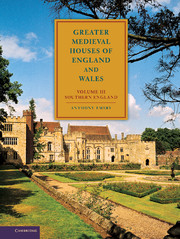Book contents
- Frontmatter
- Contents
- Acknowledgements
- List of abbreviations
- Introduction
- PART I THE THAMES VALLEY
- 1 The Thames Valley: historical background
- 2 The Thames Valley: architectural introduction
- 3 Household expansion, chambers and lodgings
- 4 The Thames Valley: bibliography
- 5 The Thames Valley: survey
- Appendix 1 The Thames Valley castles: residential additionss
- Appendix 2 The Thames Valley: residential licences to crenellate
- PART II LONDON AND SOUTH-EAST ENGLAND
- PART III SOUTH-WEST ENGLAND
- Appendix 5 Castles of south-west England: residential additions
- Appendix 6 South-west England: residential licences to crenellate
- Appendix 7 The architectural value of John Leland and the Buck brothers
- List of plates
- List of figures
- Index
- Index of houses in volumes I, II and III
1 - The Thames Valley: historical background
from PART I - THE THAMES VALLEY
Published online by Cambridge University Press: 05 June 2012
- Frontmatter
- Contents
- Acknowledgements
- List of abbreviations
- Introduction
- PART I THE THAMES VALLEY
- 1 The Thames Valley: historical background
- 2 The Thames Valley: architectural introduction
- 3 Household expansion, chambers and lodgings
- 4 The Thames Valley: bibliography
- 5 The Thames Valley: survey
- Appendix 1 The Thames Valley castles: residential additionss
- Appendix 2 The Thames Valley: residential licences to crenellate
- PART II LONDON AND SOUTH-EAST ENGLAND
- PART III SOUTH-WEST ENGLAND
- Appendix 5 Castles of south-west England: residential additions
- Appendix 6 South-west England: residential licences to crenellate
- Appendix 7 The architectural value of John Leland and the Buck brothers
- List of plates
- List of figures
- Index
- Index of houses in volumes I, II and III
Summary
GLOUCESTERSHIRE
THE River Thames and its tributaries have determined the landscape of Berkshire, Buckinghamshire, and Oxfordshire but the river barely affects Gloucestershire. Its birth there is indistinct and the nascent water barely achieves scale before it has left the county a little beyond Lechlade. The River Severn and the Cotswold hills are the primary features of Gloucestershire, determining three contrasting landscapes. The Vale of Gloucester is spanned by the Severn and its tidal estuary. The latter is flanked by the Forest of Dean towards the Welsh border and the Vale of Berkeley (a continuation of its sister vale) to the foot of the south Cotswolds. This range of hills extends the length of the county and initiates its most lovable characteristics. Beyond the Cotswold escarpment lies a broad, gently sloping limestone plateau dipping towards the distant Thames valley.
Each of these distinctive landscapes determines its building materials, population, and economic prosperity. The Forest of Dean was little populated and therefore lacks major medieval houses. In contrast, the Severn was a leading trade route, frequently subject to flooding but serving a rich pastoral region. The Cotswolds were exposed, windswept, and thinly inhabited, as some parts still are, but the hills provided some of the most profitable sheep runs in England.
Arable farming was the main source of livelihood in the early middle ages but the sheep runs developed in size between the twelfth and fourteenth centuries to become the dominating resource of the region. The lay subsidy of 1334 reveals that the income-generating resources of Gloucestershire positioned the county as eighth in England even though it had a relatively low population.
- Type
- Chapter
- Information
- Publisher: Cambridge University PressPrint publication year: 2006



